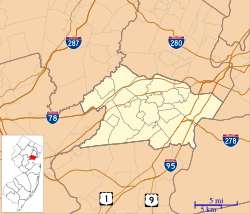Fanwood station facts for kids
Quick facts for kids
Fanwood
|
|||||||||||||
|---|---|---|---|---|---|---|---|---|---|---|---|---|---|

The Fanwood station as viewed from the pedestrian overpass on a winter afternoon.
|
|||||||||||||
| Location | South Avenue & South Martine Avenue, Fanwood, New Jersey | ||||||||||||
| Owned by | New Jersey Transit | ||||||||||||
| Line(s) | Raritan Valley Line | ||||||||||||
| Platforms | 2 side platforms | ||||||||||||
| Tracks | 2 | ||||||||||||
| Connections | NJ Transit Bus: 113 Olympia Trails: Westfield Commuter Service |
||||||||||||
| Construction | |||||||||||||
| Parking | Yes, paid and permit parking | ||||||||||||
| Bicycle facilities | Yes | ||||||||||||
| Other information | |||||||||||||
| Fare zone | 9 | ||||||||||||
| History | |||||||||||||
| Opened | January 1, 1839 | ||||||||||||
| Rebuilt | 1868 | ||||||||||||
| Previous names | Scotch Plains Fanwood Park |
||||||||||||
| Traffic | |||||||||||||
| Passengers (2012) | 974 (average weekday) | ||||||||||||
| Services | |||||||||||||
|
|||||||||||||
|
|||||||||||||
|
Central Railroad of New Jersey
|
|||||||||||||

Fanwood's former CNJ depot in January 2020.
|
|||||||||||||
| Location | 238 North Avenue, Fanwood, New Jersey | ||||||||||||
| Area | 0.5 acres (0.2 ha) | ||||||||||||
| Built | 1874 | ||||||||||||
| Architect | Central Railroad of New Jersey | ||||||||||||
| Architectural style | Late-Victorian | ||||||||||||
| NRHP reference No. | 80002521 | ||||||||||||
| Added to NRHP | July 17, 1980 | ||||||||||||
The Fanwood train station is in Fanwood, New Jersey. It is part of the New Jersey Transit system. Trains on the Raritan Valley Line stop here. The station has a beautiful old building on the north side of the tracks. This building is from the Victorian era. It is now used by a non-profit group. You can find the ticket office in the station building on the south side. The Fanwood station was added to the National Register of Historic Places in 1980. This means it is an important historical place.
Contents
History of Fanwood Station
Early Beginnings: Scotch Plains Station
The very first train station in this area was built in 1837. It was called the Scotch Plains station. This station was about a quarter-mile north of where the current station is. The Elizabethtown and Somerville Railroad opened this line. At that time, trains used wood-burning engines. These engines were not strong enough to climb steep hills. So, the original tracks had to go around the Fanwood hill. Today, Midway Avenue follows the path of that old train line.
Moving the Tracks and Naming Fanwood
Later, trains started using more powerful coal-burning engines. These new engines could climb hills. Because of this, the Central Railroad of New Jersey decided to move the train line. They started buying land in 1867 for the new tracks. The company had to buy all the land between the old and new lines. This land was shaped like a fan, wide at one end and narrow at the other.
The station's name was changed from Scotch Plains to Fanwood Park. The name "Fanwood" came from Miss Fanny Wood. She was the daughter of a railroad official. The railroad company also developed the land around the new station. They created suburban housing lots with curved streets. This new area was called Fanwood Park. A company connected to the railroad built and sold houses there for 40 years. The Borough of Fanwood was officially created in 1895.
The Fanwood Station Buildings
The Fanwood Station Complex includes three main parts. There is the main station building, a shelter, and an overpass.
- The main station building was built in 1874. It has a popular Victorian style called Carpenter Gothic. This style often features decorative "gingerbread trim."
- The shelter was built in 1897. It was designed for baggage and as a waiting area for passengers on the south side of the tracks. It looks similar to the main building.
- The overpass was built in 1946. It is a bridge that connects the two sides of the tracks.
The Fanwood station was officially recognized as a historic place on July 17, 1980.
Station Layout and Platforms
The Fanwood station has two low-level side platforms. This means the platforms are at ground level. Passengers use these platforms to get on and off the trains.
| M | Overpass | Connection between platforms |
| G | ||
| Side platform | ||
| Track 1 | ← Raritan Valley Line toward Raritan or High Bridge (Netherwood) | |
| Track 2 | Raritan Valley Line toward Newark Penn Station (Westfield) → | |
| Side platform | ||
| Street level | Station building, parking, buses | |




